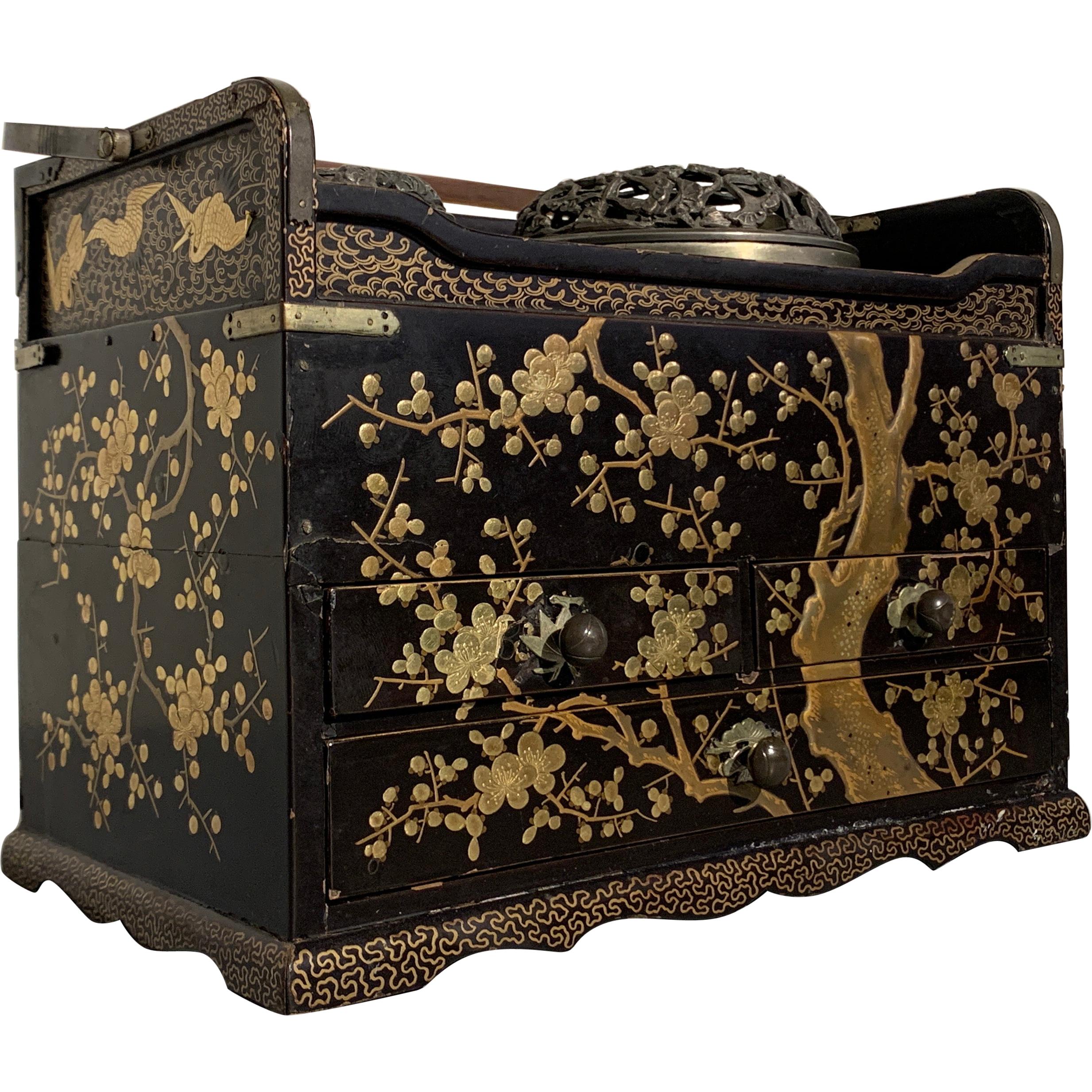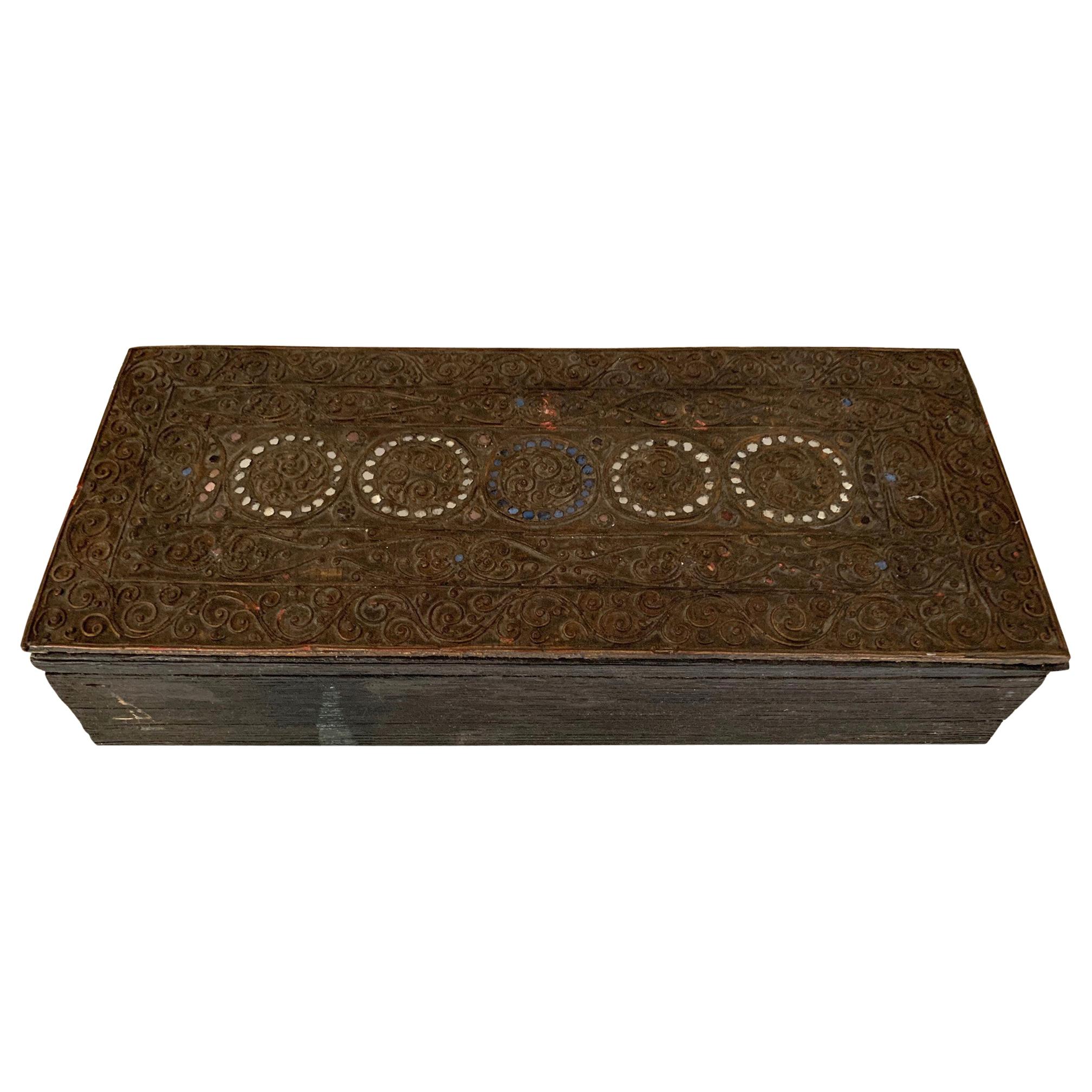Items Similar to Rare 17th Century Japanese Export Lacquer Medical Instrument Box
Want more images or videos?
Request additional images or videos from the seller
1 of 8
Rare 17th Century Japanese Export Lacquer Medical Instrument Box
About the Item
A rare Japanese export lacquer medical instrument box
Edo-period, 1650-1700
L. 19 x W. 6 x H. 8.5 cm
This unconventionally shaped lacquer box, decorated in the pictorial-style, reveals a highly specialist functionality. The cylinder-shaped container with a variety of compartments, drawers, all the original brass ware and a nashiji interior, once contained a set of medical instruments for bleeding and cupping. The originally Chinese procedure of attaching heated glass cups to the body to cure patients of ‘imbalanced humours’ gathered great interest from European physicians stationed in Japan and other Asian trade posts. Bleeding, or bloodletting, on the other hand was an ancient European approach to healing, that was introduced in Asia by Christian missionaries.
We know only a few boxes of these kind, which serve as a symbol of medical knowledge exchange, exist. One of them, a transitional style one the whereabouts of which are unknown. A second one, in the pictorial-style, lacking the brass ware interior was auctioned at Christie’s in 1996 (both llustrated in ,Oliver Impey & Christiaan Jo¨rg, Japanese Export Lacquer 1580-1850, Hotei Publishing, Leiden, 2005, p. 115). The present one is similar in decoration to the one sold at Christie’s but has the rare interior with all the original brass fittings.
- Dimensions:Height: 3.35 in (8.5 cm)Width: 2.37 in (6 cm)Depth: 7.49 in (19 cm)
- Style:Edo (Of the Period)
- Materials and Techniques:
- Place of Origin:
- Period:
- Date of Manufacture:1650-1700
- Condition:Wear consistent with age and use.
- Seller Location:Amsterdam, NL
- Reference Number:1stDibs: LU5458233886852
About the Seller
5.0
Vetted Seller
These experienced sellers undergo a comprehensive evaluation by our team of in-house experts.
Established in 1985
1stDibs seller since 2020
19 sales on 1stDibs
Typical response time: 3 hours
- ShippingRetrieving quote...Ships From: Amsterdam, Netherlands
- Return PolicyA return for this item may be initiated within 7 days of delivery.
More From This SellerView All
- Japanese Export Nagasaki Lacquer Box with the Portrait of Napoleon BonaparteLocated in Amsterdam, NLA Japanese export Nagasaki lacquer tobacco box with the portrait of Napoleon Bonaparte Edo-period, circa 1810 The box in black lacquer on copper, ...Category
Antique 19th Century Japanese Edo Lacquer
MaterialsCopper, Gold
- 17th Century Japanese Export Lacquer Cabinet with Depiction the Dutch TradepostLocated in Amsterdam, NLA highly important Japanese export lacquer cabinet with depiction of the Dutch East India Company tradepost Deshima and the annual Dutch delegation on its way to the Shogun in Edo Edo period, circa 1660-1680 H. 88 x W. 100.5 x D. 54 cm This cabinet includes a later European japanned stand, but also a modern powder-coated steel frame. The latter can be designed and added to your specific needs. The sides and front of the rectangular two-door cabinet are embellished in gold and silver hiramaki-e and takamaki-e on a black roiro lacquer ground with a continuous design. The two doors depict a long procession of numerous figures travelling on foot and horseback along buildings and a pagoda into a mountainous landscape. This is the annual court journey, Hofreis, of the Dutch from Nagasaki to the Shogun’s court in Edo. Three horseback riders are dressed as Dutch merchants and a fourth figure, probably het Opperhoofd, is seen inside a palanquin, norimon. Just about to cross the bridge, two men are carrying a cabinet like the present one. Many Japanese figures on either side of the procession are engaged in various activities; some play musical instruments on board of small boats, others are fishing; figures inside buildings are depicted playing go, and farmers are tending to their rice paddocks. The upper part of the right door shows a large mansion, probably the local daimyo’s castle, with men kneeling before a man in the central courtyard. The court journey fits in with the foreign policy of the shogunate which accorded a role to the VOC alongside China, Korea, and the Ryukyu Islands who also had to pay tribute. However, the VOC employees were traders, having low status in Japan’s social hierarchy, and they were received with less deference than were the state embassies from Korea and the Ryukyu Islands. Nevertheless, the contacts with the Dutch were a welcome source of information to the Shogun about Europe and European science and technology. The left side of the cabinet depicts, in mirror image, a rare view of the artificial fan-shaped Deshima Island, the trading post for the Dutch in Japan. The island, where the Dutch flag flies, is surrounded by small Japanese boats and an anchored three-masted fluyt (cargo ship), flying Dutch flags, with on the stern the VOC monogram. On the bottom right a busy street of Nagasaki is shown, bordered by shops and leading up to the stone bridge. On the island the trees are beautifully painted, two cows can be seen, and the flagpole, all in very fine detail. Dutchmen and enslaved Malay are visible outside the buildings and two Japanese figures, probably guards, sit in a small hut in the centre. A maximum of fifteen to twenty Dutchmen lived on the island at any time and soldiers or women were not allowed. Restrictions on Deshima were tight, and the merchants were only allowed to leave the island by special permission. The Opperhoofd had to be replaced every year, and each new Opperhoofd had to make a court journey to pay tribute, present gifts, and to obtain permission to Margaret Barclay eep on trading. In the distance, many birds fly above the hills and a four-story pagoda can be seen. The right side of the cabinet is painted with other horse riders and their retinue journeying through mountains. The pair of doors to the front open to reveal ten rectangular drawers. The drawers are decorated with scenes of birds in flight and landscapes with trees and plants. The reverse of the left door with two thatched buildings, one with a ladder, underneath a camelia tree with large blooms; the right door with a three-story pagoda nestled among trees and both doors with a flying phoenix, ho-oo bird. The cabinet, with elaborately engraved gilt copper mounts, hinges, lock plates and brass handles, is raised on an 18th-century English japanned wood stand. A pair of large cabinets...Category
Antique 17th Century Japanese Edo Lacquer
MaterialsCopper, Gold
- Extremely Fine and Rare 17th-Century Japanese Export Lacquer and Inlaid CabinetLocated in Amsterdam, NLAn extremely fine and important Japanese lacquer cabinet with gilt-copper mounts for the European market Edo period, late 17th century The pictorial style decorated rectangular...Category
Antique Late 17th Century Japanese Lacquer
MaterialsBrass
- Fine 17th Century Japanese Export Black and Gold Lacquered Pictorial-Style DishLocated in Amsterdam, NLA fine Japanese export black and gold lacquered pictorial-style dish Nagasaki or Kyoto, 1680-1720 The dish with wide flat rim of Keaki wood (Zelkova species) in black lacquer with...Category
Antique 17th Century Japanese Edo Lacquer
MaterialsGold
- Four magnificent 17th-century Japanese export gold lacquer Liquor or Gin bottlesLocated in Amsterdam, NLA set of four extremely rare and important pictorial-style Japanese export lacquer bottles Edo-period, circa 1650-1680 H. 15.5 x W. 6.9 x B. 7.6 cm (each) The bottles with red cop...Category
Antique Mid-17th Century Japanese Edo Lacquer
MaterialsCopper, Gold, Silver
- Fine Japanese Namban Lacquer Jewelry Casket, 17th CenturyLocated in Amsterdam, NLJapanese Namban lacquer transition-style coffer with two drawers Kyoto/Nagasaki, circa 1650 The cartouches with gilt and red decorations of leaves...Category
Antique 17th Century Japanese Edo Lacquer
MaterialsCypress
You May Also Like
- Japanese Lacquer Smoking Box, Tabako Bon, Edo Period, 19th CenturyLocated in Austin, TXA very fine Japanese maki-e lacquer decorated tabako bon, or smoking box, late Edo Period, mid-19th century, Japan. The elegant smoking box of black lacquer decorated with a wonderful gold lacquer takamaki-e design of a gnarled and elegantly twisted plum tree with branches in full bloom. A border of golden cranes in flight to the top. The smoking box, called a tabako bon, is comprised of an open section at the top with inset with two cylindrical metal canisters...Category
Antique Mid-19th Century Japanese Edo Lacquer
MaterialsLacquer
- Burmese Kammavaca Giltwood Box, Stand, and Manuscript, 18th/19th CenturyLocated in Austin, TXA gorgeous Burmese carved and gold leafed teakwood stand and cover for a kammavaca manuscript, late 18th or early 19th century, Burma. The manuscript chest is heavily rococo influenced, speaking to the French presence in the region at the time. The carved teak stand is formed as a raised platform set upon four large scrolling acanthus leaf feet, with carved flour-de-lis to the apron. The cover for the stand is also carved from teak, and features a series of rectangular cartouches, each set with a red foil backed glass "gem", surrounded by shell inlay, and embellished with green and silver foil backed glass sequins. The top of the cover features the same design motif, with the addition of thayo lacquer design elements, and is strongly reminiscent of Tibetan manuscript...Category
Antique Early 19th Century Burmese Rococo Lacquer
MaterialsFoil, Silver Leaf, Gold Leaf
- Burmese Buddhism Scripture with Lacquer CoversLocated in Atlanta, GAA large Theravada Buddhism scripture book from Burma, circa late 19th century-early 20th century. The book opens to continuous folding pages that is accordion like. Ink scriptures in curvy Burmese language were handwritten on both sides of the pages. The papers are bind by two lacquered wood covers with elaborate design that features relief scrolls and mini mosaic...Category
Antique Late 19th Century Burmese Other Lacquer
MaterialsLacquer, Paper
- Rare 17th Century South American ShrineLocated in Rio De Janeiro, BRRare 17th Century Cedar Shrine. Straight box with padded doors. Interior with decorative arch in the shape of a portal. Dimensions in centimeters: 52cm W x 26,50 cm D x 71 cm H. Th...Category
Antique Late 17th Century Brazilian Baroque Religious Items
MaterialsCedar
- A Very Fine Takamaki-e Lacquer Cheroot Case in the Manner of Shibata ZeshinBy Shibata ZeshinLocated in Ottawa, OntarioThe 'ishime' lacquered case consisting of two conforming molded sections with one sliding overtop the other, both sides decorated with hand painted gilt, silver & burnt dark russet (kasshoku) lacquers, depicting motifs in low relief of a rat with an acorn on one side and two acorns on the opposing. In Japanese culture rats are considered auspicious symbols of fertility & wealth, acorns symbolize prosperity & growth. Signed with characters and a mon on one edge. Takamaki-e is a lacquer technique in which metallic powders such as silver, gold, copper, pewter etc., are used in combination with lacquer & clay-dust to build up motifs in low relief. Please note that the color tones & hues of the lacquered motifs appear somewhat more vibrant in the images due to ambient lighting conditions. Regarding the opinion stating the superior quality of this fine example being likened to works associated with those by Shibata...Category
Antique 1870s Japanese Meiji Lacquer
MaterialsLacquer
- Pair 17th Century Medical Anatomy Engravings by Francesco Valesio, 1627Located in Rochester, NYTwo anatomical copper engravings by Francesco Valesio. From De humani corporis fabrica libri decem Evangelista Deuchino, Venice: 1627. Laid paper.Category
Antique 1620s European Prints
MaterialsPaper
Recently Viewed
View AllMore Ways To Browse
Antique Medical Box
Japanese Antique Bento
Vintage Japanese Bento Box
Japanese Tanzaku
Suzuki Silver
Burmese Lacquerware Betel Box
Burmese Yun
Chinese Chippendale Jewelry Box
Manju Netsuke
Pagan Bya
Temple Ranma Panel
Antique Korean Black Lacquer Mother Of Pearl
Chinese Enamel Smoking Set
Japanese Lacquer Inro Bag
Peranakan Mirror
Rabbit Netsuke Ojime
Sake Storage Container
Vintage Presentation Kimono





